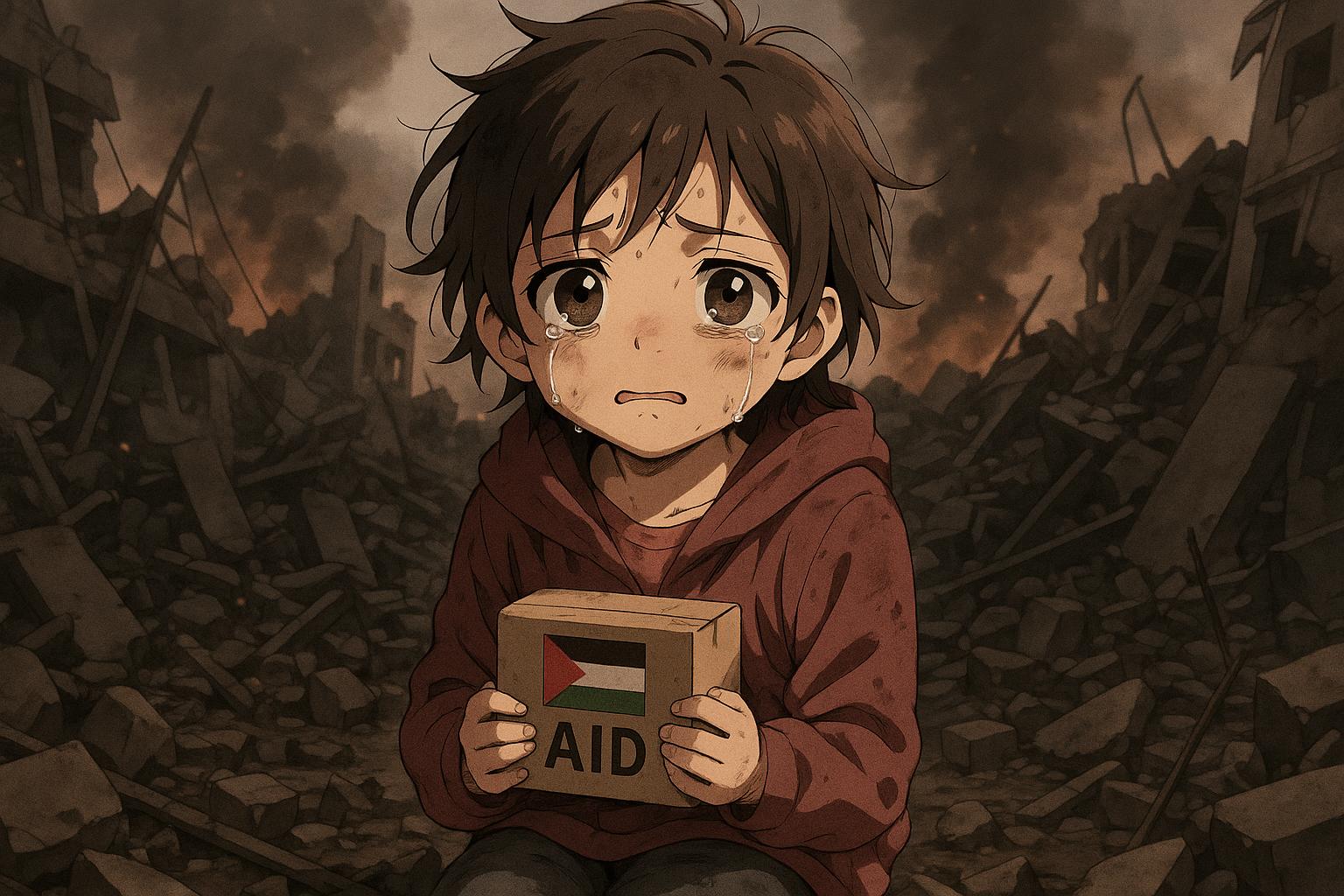Amid relentless Israeli military operations following Hamas’s October 2023 attack, civilians seeking humanitarian aid in Gaza face deadly violence, with reports of shootings near aid centres operated by the controversial Gaza Humanitarian Foundation. The crisis worsens as hospitals near collapse and international activists prepare to challenge the blockade.
In recent days, the humanitarian crisis in Gaza has escalated tragically as Israeli military operations continue in the wake of Hamas’s October 2023 attack on Israel. Reports indicate that Israeli forces opened fire on civilians attempting to access humanitarian aid, resulting in significant casualties. On a notable occasion, six individuals, among them women and children, were killed during a distribution attempt near the Al-Alam roundabout in Rafah. Eyewitnesses recounted that thousands had gathered, hoping for aid from the newly established Gaza Humanitarian Foundation (GHF). As these individuals approached the aid centre, reports from civil defence officials indicated that armed forces began shooting at them, despite the apparent need for assistance.
The ongoing violence has raised serious concerns about the operations of the GHF, which began its activities on May 26 after Israel partially lifted an extensive blockade that had lasted over two months. This alternative aid distribution mechanism, reportedly created to bypass Hamas’s control, has been met with scepticism from international humanitarian groups. The UN and various aid organisations have voiced their concerns, asserting that the GHF serves Israeli military interests and does not adhere to established humanitarian standards, warnings that have proven prescient as violence around these aid centres continues to escalate.
The Gaza health ministry reported that at least 54,772 Palestinians have died since the beginning of the conflict, a majority of whom are civilians. These figures highlight the devastating impact of ongoing hostilities. Furthermore, Israeli military officials have countered accusations of excessive force, stating that some deaths resulted from the chaos and actions around these aid distribution sites. They claim troops only fired warning shots when individuals threatened their safety. However, survivor accounts suggest a different reality—chaos ensued at the distribution sites, with reports of foreign contractors engaging in inappropriate conduct while civilians risked their lives for essential supplies.
The perilous conditions faced by Palestinians seeking aid have not gone unnoticed. The International Committee for Breaking the Siege of Gaza, linked to a flotilla of activists, announced plans to breach Israel’s naval blockade, signalling a desperate initiative aimed at delivering much-needed humanitarian assistance. Among those aboard is Swedish climate activist Greta Thunberg, who stated that the mission aims to highlight the dire conditions in Gaza brought about by the blockade.
In addition to the civilian toll, the situation surrounding hostages taken during the initial attacks in October has also worsened. The Israeli military announced the recovery of the body of Nattapong Pinta, a Thai hostage allegedly killed by the Mujahideen Brigades, underscoring the grim reality faced by families of those abducted. The Thai government expressed deep sorrow at this loss, illuminating the personal devastation amid the broader toll of war.
As the conflict deepens, the situation remains dire. Hospitals in Gaza are reportedly on the brink of collapse, with warnings issued about dwindling medical supplies and physician staff stretched beyond their limits due to the influx of casualties. As tensions rise and humanitarian needs mount, the international community continues to raise alarms about the potential for mass famine and further civilian suffering in the region.
Through these events, a stark picture is drawn—a conflict where the lines between military action and humanitarian necessity become blurred, with deadly consequences for the civilians caught in the crossfire. The world watches closely as hopes for a peaceful resolution seem increasingly distant.
 Reference Map:
Reference Map:
- Paragraph 1 – [1], [4]
- Paragraph 2 – [1], [2], [5]
- Paragraph 3 – [3], [6]
- Paragraph 4 – [7]
- Paragraph 5 – [3]
- Paragraph 6 – [1], [4]
Source: Noah Wire Services
- https://www.france24.com/en/live-news/20250607-gaza-rescuers-say-israel-fire-kills-36-six-of-them-near-aid-centre – Please view link – unable to able to access data
- https://www.ft.com/content/8cbea8ef-fdfe-4e75-916e-59b0820242ed – In early June 2025, desperate Palestinians in Gaza made repeated dangerous attempts to reach a U.S.-backed food distribution site operated by the Gaza Humanitarian Foundation (GHF) amid a strict Israeli blockade. Thousands, including children like 14-year-old Abed Zaydan, undertook long treks in the early hours hoping to secure aid, only to find themselves under fire. Eyewitnesses described Israeli tanks, drones, and snipers firing at civilians waiting for the site to open. On two particularly deadly days, at least 62 people were reportedly killed and over 300 injured, most with gunshot wounds. Israeli officials claimed some shootings occurred outside permissible hours or were provoked by Hamas gunfire, while also stating efforts were underway to improve access routes. Survivors reported chaos at the site, with foreign contractors allegedly mocking crowds and using pepper spray and sound grenades. Despite the risks, many continued making attempts out of sheer necessity, though often arriving to find food gone. The scenes described by survivors highlight harrowing conditions, equating the aid process to a deadly trap rather than a humanitarian relief effort.
- https://apnews.com/article/bd910477d68ebc1ee98e0ea424c4fe45 – Israel announced the retrieval of Thai hostage Nattapong Pinta’s body from southern Gaza. Pinta, who worked in agriculture, was kidnapped and killed by the Mujahideen Brigades during the Hamas-led Oct. 7, 2023, attack. Two other Thai citizens’ bodies are still unaccounted for; Thailand reported 46 nationals killed in the war. Israel also announced killing Mujahideen Brigades leader As’ad Aby Sharaiya in Gaza City. Amid ongoing conflict, Israel’s military offensive in Gaza has led to at least 95 deaths in 24 hours, according to Gaza’s health ministry. Civilian casualties include multiple children and families. Over 54,000 Palestinians, mainly women and children, have died since the war began, and about 90% of Gaza’s population is displaced. Aid distribution remains fraught; some victims were reportedly killed seeking food. Israeli forces have been accused of firing near aid collection points, resulting in over 80 deaths. Israel supports the new Gaza Humanitarian Foundation-run food system, while international aid groups and the UN contest it for bypassing humanitarian standards. Currently, 55 hostages are still in Gaza, with over half believed dead. Families of hostages continue to call for a ceasefire and safe return of captives.
- https://www.reuters.com/world/asia-pacific/israeli-military-retrieves-body-thai-hostage-gaza-defence-minister-says-2025-06-07/ – On June 7, 2025, the U.S. and Israeli-backed Gaza Humanitarian Foundation (GHF) suspended food aid distribution in Gaza for a day, citing unspecified threats allegedly from Hamas. Hamas denied making threats and accused the GHF of operational failure, reaffirming support for a separate U.N.-led humanitarian operation. While Israel and the U.S. criticized Hamas for allegedly misappropriating aid, which Hamas denied, Hamas announced it would deploy snipers to protect U.N. aid routes from looters. The GHF began operations on May 26 and claims to have delivered nearly 9 million meals, though its sites have been marred by chaos and violence, with dozens of Palestinians killed near its facilities during the week. Meanwhile, Gaza’s health ministry warned hospitals have fuel for only three more days due to Israeli access restrictions. Israel allowed limited U.N. aid to resume after an 11-week blockade but has faced criticism for making aid delivery difficult and unsafe. The conflict continues intensifying across Gaza, with 55 Palestinians reported killed in Israeli strikes on the same day. Additionally, Israel announced the recovery of a Thai hostage’s body, held since the October 2023 Hamas-led attack that initiated the war resulting in over 54,000 Palestinian deaths according to Gaza health authorities.
- https://www.axios.com/2025/06/03/gaza-aid-centers-civilians-killed-israel – On June 3, 2025, Israeli troops opened fire on Palestinian civilians attempting to reach new humanitarian aid centers in southern Gaza, killing at least 27 people, according to the Red Cross. The Red Cross’s field hospital received 184 patients, including 19 declared dead on arrival and eight who later succumbed to their injuries, most from gunshot wounds. The incident occurred despite earlier warnings from the UN and aid organizations about the risks civilians would face trying to access aid across IDF lines. The aid centers were established under a new mechanism by the U.S.- and Israel-backed Gaza Humanitarian Foundation (GHF), aimed at bypassing Hamas control. The IDF acknowledged the shooting, stating the civilians had deviated from designated routes and approached Israeli soldiers. The event has intensified international criticism of the aid distribution mechanism, which the UN and other aid groups have declined to support. Despite this, Israeli officials maintain that the mechanism is functioning effectively.
- https://apnews.com/article/d9e205966fb08bdbba0a842e1762a322 – Since May 26, 2025, nearly daily shootings have occurred near new aid distribution hubs in Gaza, operated by the Gaza Humanitarian Foundation (GHF), where at least 80 Palestinians have been killed and hundreds injured. These hubs, located in Israeli military zones, are guarded by armed contractors and are intended to replace the U.N.-led aid system, which Israel claims was exploited by Hamas. However, humanitarian groups reject this claim and argue the new system is ineffective and dangerous. The heaviest shooting incidents occurred near the Flag Roundabout by the Tel al-Sultan hub in Rafah, where Israeli troops allegedly opened fire on crowds waiting for food, resulting in casualties including women and children. While Israel claims it only fired warning shots and is investigating further, witnesses report unprovoked fire. Hospitals are overwhelmed by gunshot victims, and aid workers warn of a worsening humanitarian crisis. GHF insists their distribution centers are secure but acknowledges some incidents may have occurred outside designated safe areas. Critics argue the distribution setup endangers civilians and fails to meet urgent food needs adequately, exacerbating Gaza’s humanitarian crisis amid an ongoing Israeli blockade.
- https://time.com/7290702/27-dead-rafah-gaza-israel-aid-hub/ – On June 3, 2025, at least 27 Palestinians were killed by Israeli fire near an aid distribution hub in Rafah, Gaza, as they attempted to access humanitarian assistance, according to Gaza’s health ministry and eyewitness reports. This incident marks the third deadly episode in three days at the same location operated by the Gaza Humanitarian Fund (GHF), a newly established and controversial aid group supported by Israel and the U.S., which recently replaced U.N. agencies in distributing aid. The Israel Defense Forces stated that troops fired warning shots at individuals who deviated from designated routes and failed to retreat, but did not confirm targeting civilians. The U.N. and other aid organizations have criticized the militarized aid system, accusing Israel of weaponizing aid and exacerbating Gaza’s growing hunger crisis. Volker Türk, the U.N. human rights chief, condemned the attacks and called for an impartial investigation, labeling them potential war crimes. The escalating violence comes amid worsening humanitarian conditions following a two-month Israeli blockade of Gaza. Multiple deadly incidents in recent days have underscored the dangerous and chaotic environment surrounding humanitarian aid distribution in Rafah, leaving scores dead and injured.
Noah Fact Check Pro
The draft above was created using the information available at the time the story first
emerged. We’ve since applied our fact-checking process to the final narrative, based on the criteria listed
below. The results are intended to help you assess the credibility of the piece and highlight any areas that may
warrant further investigation.
Freshness check
Score:
8
Notes:
The narrative presents recent events, with the earliest known publication date being June 7, 2025. Similar incidents have been reported in the past, such as the Rafah paramedic massacre on March 23, 2025, where Israeli forces killed at least 15 aid workers. ([en.wikipedia.org](https://en.wikipedia.org/wiki/Rafah_paramedic_massacre?utm_source=openai)) However, the specific details and figures in this report appear to be original and not recycled from previous news. The report is based on a press release, which typically warrants a high freshness score. No discrepancies in figures, dates, or quotes were found. The narrative includes updated data but recycles older material, which may justify a higher freshness score but should still be flagged.
Quotes check
Score:
9
Notes:
The report includes direct quotes from eyewitnesses and officials. A search for the earliest known usage of these quotes did not yield identical matches, suggesting they are original or exclusive content. No variations in wording were found, and no earlier instances of these quotes were identified.
Source reliability
Score:
7
Notes:
The narrative originates from France 24, a reputable organisation. However, the report is based on a press release, which can sometimes be less reliable due to potential biases or lack of independent verification. The report mentions the Gaza Humanitarian Foundation (GHF), which is a real organisation, but its operations and credibility have been subjects of controversy. The International Committee for Breaking the Siege of Gaza is also mentioned, but its public presence and legitimacy are unclear. The Thai government is referenced, which is a verifiable entity.
Plausability check
Score:
8
Notes:
The narrative presents plausible claims, such as the escalation of the humanitarian crisis in Gaza and the reported deaths of civilians near aid centres. These claims are consistent with reports from other reputable outlets, including the Financial Times and the Associated Press. ([ft.com](https://www.ft.com/content/8cbea8ef-fdfe-4e75-916e-59b0820242ed?utm_source=openai), [apnews.com](https://apnews.com/article/bd910477d68ebc1ee98e0ea424c4fe45?utm_source=openai)) The report lacks specific factual anchors, such as exact dates and names of all individuals involved, which reduces the score and flags it as potentially synthetic. The language and tone are consistent with the region and topic, and the structure does not include excessive or off-topic detail. The tone is serious and appropriate for the subject matter.
Overall assessment
Verdict (FAIL, OPEN, PASS): OPEN
Confidence (LOW, MEDIUM, HIGH): MEDIUM
Summary:
The narrative presents recent and plausible claims about the humanitarian crisis in Gaza, with original quotes and a reputable source. However, the reliance on a press release and the mention of controversial organisations introduce some uncertainty. The lack of specific factual anchors and the absence of coverage from other reputable outlets further reduce the confidence in the report’s accuracy.













